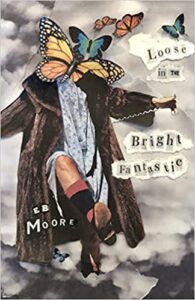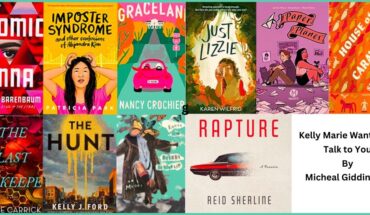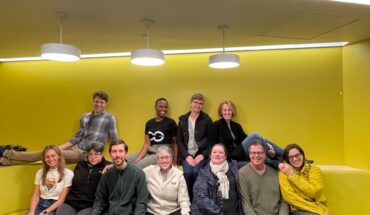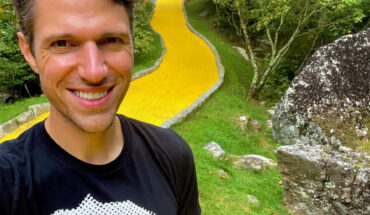 E. B. Moore’s Loose in the Bright Fantastic (available now) follows gray-haired Maggie as she escapes from the hospital, wearing only her johnny, an ancient mink, and her dead husband’s oversized wingtips. She’s on the loose in Boston’s Public Garden where old memories take her to long-gone haunts, from tea at the Ritz to the South End. After homeless nights, she finds home and invades a party in the house where she’d raised her children.
E. B. Moore’s Loose in the Bright Fantastic (available now) follows gray-haired Maggie as she escapes from the hospital, wearing only her johnny, an ancient mink, and her dead husband’s oversized wingtips. She’s on the loose in Boston’s Public Garden where old memories take her to long-gone haunts, from tea at the Ritz to the South End. After homeless nights, she finds home and invades a party in the house where she’d raised her children.
While Maggie’s confusion escalates, her favorite grandson Hank (AKA Major Amazing Man), in cape and mask, sets out on his own to find her, leaving his mother beyond frantic when bloody evidence says the worst has happened.
This novel is informed by the eight years Moore’s mother lived with her and her children, suffering from failed brain surgery.
Christine: Your earlier work, including your poetry collection, New Eden, A Legacy, includes substantial connections to Amish culture. What is it about this community which has drawn your attention so often? Did you decide to make a deliberate break from that subject matter for your third novel?
Liz: The Amish were part of my family history, and I based those three books on dark stories my mother told me about my grandparents and great grandparents.
Originally, I had included a more modern section in An Unseemly Wife with Maggie, a character based on my mother, but Maggie resisted coming fully alive on the page. I had to cut her. It turned out, she just wanted her own book, one with a lighter side of a dark subject, and finally she got it in Loose in the Bright Fantastic.
Your publisher’s website states, “In the middle of raising her family, [EB Moore’s] mother moved in following unsuccessful brain surgery. The family coped by finding the lighter side of outlandish happenings over the eight years they lived together; these experiences partly served as the basis for writing Loose In The Bright Fantastic.” Much has been made of the conversation between a writer’s private life and their public work. How did you decide which aspects of your lived experience to mine for your novel, and which to leave behind?
In the past, I wrote about long dead members of the family, so I didn’t have to worry about their reaction. That included my grandmother who died when I was six, though my mother’s bedtime stories brought the rest of the clan close. I felt a little odd giving my great grandmother a sex life, but let’s face it, that’s part of a whole story. That aspect of An Unseemly Wife shocked some of the diehard fans of Amish “bonnet-rippers.” My book was not of that genre, though it was often shelved under Christian reading. One reader was so appalled she sent it back to the publisher with a stiff note on their shameful words.
As far as what aspects I chose to tell, the real truth was the emotional underpinnings surrounding our lives. Then, when I put the character Maggie in the hospital, she took off dragging me through her old memories. I then gave her a bunch of mine, along with my growing suspicion of where old age might drag me. Many of the characters and situations, though possible, even probable, were entirely invented.
Loose In The Bright Fantastic is told from three perspectives, but not three separate voices (alternating chapters in the close third). Was the novel always structured in this way? How did you come to this choice?
The book starts in Maggie’s POV, but I realized she was too unreliable to give the reader a full picture of events. I needed her daughter’s perspective for a bit of grounding in time and space, plus Clair has to ride herd on the other characters complicating the situation: Hank the five-year-old Mr. Major Amazing Man in cape and mask; his two adolescent siblings; an antagonistic ex (my ex is not antagonistic); a gay brother (and my brother isn’t gay), a slavering wet-bearded dog (all too real and very wet), and a gaggle of mice running a wheel to nowhere.
Beyond that, I wanted to show how my mother struggled her way from being comatose in a hospital bed, learned to talk again, to walk, and grew into her second childhood. While Maggie does this, her grandson and best friend, Hank, grapples with his family’s differing expectation: You’re too young to stay up watching scary movies, too old for imaginary friends. At opposite ends of the age spectrum, Maggie faces these same issues. Her family portraits are her friends. They don’t grouse about ice cream for breakfast or how many olives she likes in her martini.
Hank wants to be Maggie’s savior with the help of his mask and cape, and intends to never leave them behind. He and Maggie understand each other in a way no one else can. They egg each other on, getting into all sorts of trouble after he runs away from home to find her. On their way to deeper trouble, they hang out in a homeless squat and spend the night in the South End Public Library. Maggie is climbing into being five and he is reluctantly climbing out.
The points of view are told in the third person using the kind of language each character would use if presented in the first person. Maggie is the only one with sections in italics, as she’s thinking in the first person.
To me, this novel reads as a love letter–to life, to youth, to family, and to the city of Boston. The scope of the novel is epic, even more so when one realizes it is only 219 pages! How did you balance the intimacy of your characters’ minds with the broader themes of history and memory?
The book is a love letter to all those things, but mostly to my mother who was a spectacular, gutsy, and talented woman. Despite everything she lost, she never thought of calling it quits. She made the most of every step forward, intending to live to a hundred and twenty-five. And live happily. She never knew the mistake the doctor had made, and we didn’t tell her. She thought of him as family and trusted him. I couldn’t take that away from her.
The broader themes were the soup we swam in, living the history in one way or another, though not necessarily incident by incident of the book. It was fun writing my way back to an earlier Boston, revisiting places I loved like The Boston Garden and the South End with its elegant Victorian houses. I lived in and remodeled the house Maggie invades thinking it’s hers. So you see Maggie isn’t just founded on my mother, she’s a mixture of people including our Amish relative.
For me, writing the book was a way to let go of the anger over her needless destruction. Or at least try.
I am obsessed with the book cover! What was the process of creating this masterpiece?
I’m delighted you like it. I had fun making it. The idea for the cover’s picture came from the beginning. I had my partner take photos of me in my mother’s mink, a hospital johnny, and a pair of large wingtips I’d found at a thrift store. Dancing around the Boston Public Garden the way Maggie did seemed the perfect setting. Fortunately, sense prevailed and the pictures were taken in the privacy of our back yard. I cut the figure out of the background, and experimented with various cloud patterns. My family thought I was crazy constantly shooting photos of an overcast sky. I also tried different textures of water. The confusion of clouds turned out to work best as metaphor and background. Leaving my head in the picture didn’t work either, so I found lots of butterflies, and played around with many different designs until the collage came together.
When I asked if I could design the cover, my editor said, Well…. (clearly skeptical). You could try. After sending the image, I was gratified with her instant response, “I have to say that I really LOVE this image! It truly is eye-catching and awesome–great job!”
You have had some fantastic creative success in your life, including fellowships from The Vermont Studio Center, Yaddo, and MacDowell (to work on Loose In The Bright Fantastic) and a starred review from Kirkus for your second novel, Stones In The Road, as well as a career as a poet and a metal sculptor. How does this level of professional achievement align with your personal definition of success?
It’s funny how the pile of rejections (rejections every writer and artist gets) tends to make successes seem momentary, shooting stars that disappear in the dark. For me, success is that bright shiny object looming just out of reach, but I feel grateful and incredibly lucky to have been included in those retreats. I applied for fall or winter, times that tend to be more accessible and less socially distracting than summers are rumored to be. It was such a luxury to be there with no responsibilities, that I had to take advantage of every second, using meal time (and delicious they were) to connect with other residents. The generosity of those places can’t be underestimated.
Historical fiction, contemporary fiction, poetry, and metal sculpture–you have created work across diverse mediums. How is novel-writing similar and different from other artistic mediums?
When I switched from metal sculpture, I had no idea how similar the process could be. In metal, I worked in a large machine shop with masses of tools, both antique and modern. I shared the studio with two artist/fabricators whose work was so different from mine that we didn’t give each other suggestions the way my writing cohort does. In building a sculpture, I started with the general motion of a skeleton (I studied anatomy for years) then laid the muscles on rod by rod or used hammered sheets, until the body took shape, turning the piece round and round to check it from every angle. I use the same layering with words filling out a character.
The difference comes in the tools and the muscle driving them. I loved the feel of the tools and the physicality of the work, but in the end, it was debilitating.
Sculpture at least tended to leave me alone at night. Writing is relentless. The words drip, drip, drip, into the wee hours, and if I don’t take notes, I’ll forget the ones that work. Sometimes the ones that seem to work are ridiculous in the light of day.
Loose In The Bright Fantastic is your third novel, in addition to a collection of poetry. What was your path to publication (and how many other novels do you have sitting in a desk drawer)?
Before the Novel Incubator I wrote Stones in the Road, and tried to get an agent. One out of many wrote back after a short story taken from the book won a prize in a literary magazine. When he read the whole novel, he said no one wants to read a young boy’s coming of age story. That seemed like odd advice, but what did I know? So, I continued on with the other book and joined the Incubator’s first year. The teachers, Michelle Hoover, Lisa Borders, and the nine other Incubees made the publishing possible. They helped me hone the story to the point that at the Muse an agent wanted to see the full manuscript. She took it and managed to get a publisher. When they offered me a two-book deal, she asked if I really wanted to do that. Why wouldn’t I? She said the pressure of a two-year turn-around time could be daunting. No problem I said. I already have the second book written. I did have to rewrite it, applying things I’d learned in the Incubator.
The third book was more problematic after a snafu with my publisher’s marketing. They’d fired the marketer three months before the pub-date and didn’t tell me. The word didn’t get out, and I was clueless how to go forward. The big publishers, to a one, said they didn’t know how to sell the third book despite it being the topic of the day. Clearly, they didn’t bother to read it. Fortunately, Alison Lewis at Frayed Edge Press did read it, and now it’s coming out.
As far as other writing goes, I’m working on a book of poems, and have a fractured fairy tale (illustrated) out for consideration, as well as another novel under contract at a different small press. They haven’t announced a pub date yet.
What advice do you have for new writers?
Write for the joy of it, it could save your life.
Now the most important question: from one Mainer to another, where are the best lobster rolls?
Shamefully enough, I don’t salivate over lobster rolls. But a boiled lobster is a different matter. It has to be from Maine, boiled or steamed in seawater, then I’ll dissect and eat every leg, claw, tail, green innards, and hopefully a good chunk of red roe.
E.B. Moore grew up in a Pennsylvania fieldstone house on a Noah’s ark farm. The red barn stabled animals two-by-two, along with a herd of Cheviot sheep. After a career as a metal sculptor, she returned to writing poetry. Her chapbook of poems, New Eden, A Legacy (Finishing Line Press, 2009) was the foundation of her novel, An Unseemly Wife, both based on family stories from her Amish roots in Lancaster. E. B. received full fellowships to The Vermont Studio Center. Yaddo, and MacDowell. She is the mother of three, the grandmother of five, and lives in Scarborough, Maine.




1 comment